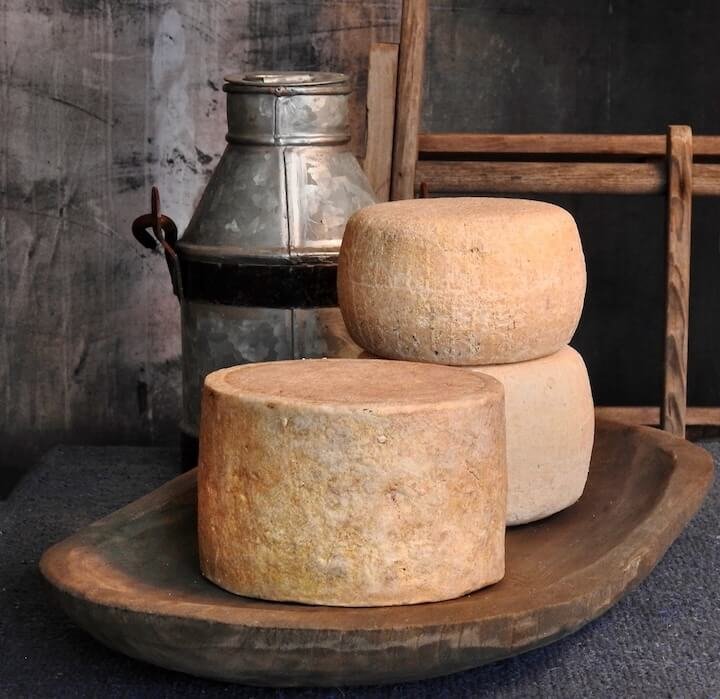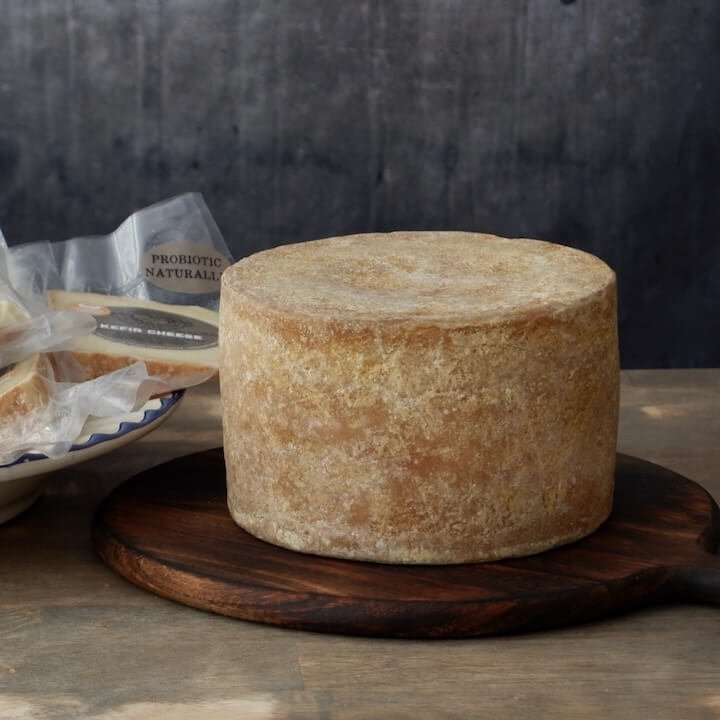
Get To Know Our Cheese
Every cheese starts (historically) with the same four ingredients: milk, salt, good bacteria, and rennet. Our cheeses are only made from sheep Milk, salt, KEFIR, and lamb Rennet. Yet anyone who’s ever gone shopping for cheese knows that those basic ingredients can yield fascinatingly different cheeses.
How do you choose a cheese you’ll love? The easiest way is to get a general understanding of the six basic types of cheese. Start with this cheese guide, and we’ll have you talking like a cheese pro in no time. Find the perfect cheese for any recipe or cheese tray with this handy cheese guide with info for cheese lovers of any skill level.

Types of Cheese
Fresh Cheese
These soft and rindless types of cheese are crafted within a day and are meant to be enjoyed soon after they’re made. Some of the different cheeses in this category include:
Caciotta Fresca: Usually made from different types of milk; characterized by a soft paste-like texture and a sweet milky taste, it lends itself to many gastronomic possibilities. For example, combine it with cold cuts, sausage, fresh vegetables, olives, and even jams or honey. Aged from 1 -2 months.
Cottage Cheese: This is a fresh cheese curd product with a mild flavor. It is also known as curds and whey. This cheese shouldn’t be aged and eaten as fresh as possible. Made by draining the cheese as opposed to pressing it. Our Cottage Cheese retains some of the whey, keeping the curds loose. No added salt. The best recipes known are from Central and Eastern Europe.
Feta: This fresh cheese originally hails from Greece, where it was traditionally made from sheep’s or goat’s milk. These days, it’s widely made in North America, too. Our Feta is made from sheep’s milk only, hence it has a reacher and more buttery flavor, with a softer silky texture, a bit crumbly. It’s creamer and has flavourful curd because of a longer fermentation time. It’s air-dried and formed into ‘chevre’ form. The flavor itself is sharp, tangy, and slightly salty.
Labneh: Soft cheese made by straining Sheep’s milk yogurt to remove the whey. It has a thick, spreadable texture similar to soft goat cheese or cream cheese, and thanks to its yogurt base, its flavor is rich and tangy. We store our Labneh cheese in grape-seed oil in a glass jar to prolong its shelf life.
Log Cheese: Strained Kefir adding Sea Salt, no rennet. We make Log Kefir Cheese in three ways: black pepper, paprika and cayenne, and Tuscany herbs. Fantastic for a cheese board, on or with some bread or crackers.
Pecorino Fresco: Washed rind cheese. One of the most popular cheeses in Italy (alternatives to feta and mozzarella), this slightly salty variety has a moist, silky texture and mild flavor. It’s best cut by itself, great with savory salads or sweet pairings of fruits or honey. Can be used for pizza or pasta.
Ricotta Cheese: is an Italian whey cheese made from sheep, cow, and goat left over from the production of other cheeses. Very low in fat, high in protein. Ricotta curds are creamy white in appearance, and slightly sweet in taste. Great with sandwiches, savory salads or sweet pairings of fruits or honey, or staffing ravioli.
Soft-Ripened Cheese
These fresh and creamy cheeses have soft, sometimes fuzzy or wrinkly rinds, a result of a natural mold that has been added to the milk during the cheese-making process. Often found on a cheese board, these types of cheese become luscious and fuller in flavor when served at room temperature.
Tomette de Brebis: This is a sophisticated cheese traditional to the Basque region of the Pyrenees. It is noted for its complex, layered flavor and adorably small size. Our aged Tommette is made from the richest sheep milk that we get in the fall and aged at least six months to yield a semi-soft cheese unlike any other made in Canada. It is rich and sharp, deep and earthy, and will leave you wanting more for hours after eating it.
Dessert Cheese
Brunost: A brown cheese? Yes—though the color might look a little funky at first, this sweet, semifirm cheese from Norway is cooked until caramelized (that’s what makes it brown). Our Brunost, made from sheep’s Milk, offers a smooth, sweet, and vaguely fudge-like flavor. Serve it the way the Norwegians do—alongside fresh fruit for dessert or our way is with honey.
Semihard Cheese
Semihard cheeses have a smooth interior and high moisture content. As they age, they become more firm and pungent. Some cheeses in this category can be either semisoft or semihard, depending on how long they’ve been aged. Here are some of the most popular cheeses in these categories:
Caciotta: This cheese was invented mainly as an alternative to pecorino – with the aim of making a product that was sweeter and more delicate, but also faster and easier to prepare. Caciotta describes a wide range of simple, rural cheeses from central Italy that can be made with either ewe’s, cow’s, goat’s, or buffalo’s milk. Ours is from Sheep Milk only. The cheese is aged for a brief period. Beneath the soft, yellow rind is a white or yellowish body that has a soft texture and mild flavor. Our this sheep’s milk cheese has a mellow, nutty flavor. Serve it on a charcuterie plate, and eat it fresh in vegetable-based appetizers or with fresh and dried fruits. Enjoy it on a cheese board before dinner, or for dessert with bread and jams. Young Caciotta (Fresca) aging from 1-2 months. Aged Caciotta is from 6, 12, and 24 months. We offer additional flavors Regular, Black Peppercorns, and Fenugreek. Also, we are going to have Sun-dried Tomatoes.
Dry Jack: is an aged version of the Monterey Jack. Hard cheese, aged from six months to up to four years. Dry Jack Cheese is made with a longer cook and stirs time to dry out the curds, then it is pressed in a cloth without cheese molds. Once formed, a spicy surface rub with cocoa, pepper, coffee, and oil is applied to the surface while aging. This process creates a spectacular presentation and yummy cheese. Firm in texture with a pale yellow pate, the cheese has a rich, nutty yet mild and assertive flavor. As the cheese ages, Dry Jack wheels become increasingly brittle and become similar in texture to Parmesan. The cheese can be shredded, cooked, sliced, or even eaten as it is.
Halloumi: Halloumi is a semi-soft, brined cheese native to Cyprus. Because the curds are heated before being brined and shaped, halloumi has an exceptionally high melting point. This allows the cheese to crisp instead of melt when grilled or fried. That crispy-on-the-outside-soft-on-the-inside character has given Halloumi its moniker as “the squeaky grilling cheese.” Our halloumi is mildly salty and almost nutty in flavor. Grilled, fried, BBQ – all are great options as an appetizer or with salad.
Hard Cheese
In general, cheeses become firmer and more pungent as they age. The hard texture of these types of cheeses makes them the best cheese for grating, and their taste is sharp. Look for these cheese names when seeking great graters!
Gouda: When young, this cheese has a semi-hard, creamy texture and slightly nutty flavor. An aged Gouda is great for a cheese board. We have a Young Gouda 4 weeks; Young Mature 8-10 weeks; Mature 16-18 weeks; soon coming an Extra Mature 7-9 months Old; 10-12 months and by 2022 we will have a Very Old – over 12 months. Basil Pesto Gouda; Spinach Pesto Gouda; Fenugreek; Sundried Tomatoes Pesto is coming too.
Pecorino Stagionato: The tradition of making pecorino dates back to at least the year zero when it was a delicacy for Roman noblemen. The name Pecorino comes from “pecora,” the Italian word for sheep. Stagionato means aged. We age our Pecorino for 12 months, then 24 and 36. Pecorino has distinctively sharp and salty flavors, also buttery and nutty. Little goes a long way to add so much flavor to pasta and salads and definitely a cheese board.
Pecorino Porto: this marbled cheese is made from full sheep milk with 10-year-old Porto (port) and has been carefully monitored and matured for 36 months. The full-bodied, intense flavor and taste of Porto is greatly admired by true cheese aficionados. Hand-crafted cheddaring techniques use the traditional clothbound method for cheese aging. When cut open, beautiful crystal formations are visible to the naked eye.
Pecorino Limited Edition: fully Stagionato has been aged for 36 months. NO rind due to unique aging technique. Colour: milky white. Aroma: strong. Taste: sharp and a bit spicy. Like most aged hard cheeses requires time to open up, and for a faster result, you can shave the cheese. It will give instant satisfaction with a fantastic, long aftertaste. Recommended wine: The more unusual the cheese, the more impressive the vino should be. Try from the Piedmont region medium to full-body Barolo wine; Brunello, Amarone. Full-body Malbec.
Ricotta Salata: from the Pecorino family maintains a unique freshness. It’s more of an aged version of regular Ricotta, and as the name implies, it’s salty – “salata.” While Ricotta is almost sweet, Ricotta Salata is salty, and where ricotta is soft and liquidy, Salata is dry and firm, buttery but crumbly. It can easily be shaved or grated, making Ricotta Salata a great option for pasta, risotto, salads, a sandwich, in a scramble, or on a burger. Atop a salad of arugula with beets and apples, finished with a squeeze from an orange slice and your best olive oil. Added to blood orange segments, fennel, pear, hazelnuts, and parsley leaves. As the finisher for a sautes of lemony kale.

Different Cheeses For Different Uses
Best Types of Cheese for Grating
Cheese names that come top of mind when it’s time to add a finely grated finishing touch to soups, salads, and pasta dishes include aged Pecorino Aged, Caciotta, Gouda, Ricotta Salata, and Halloumi.
Best Types of Cheese for Slicing
Because they’re sliceable, the following are some of the more popular cheeses for sandwiches, both grilled and cold: Pecorino Aged, Caciotta Aged, Gouda, Ricotta Salata, Halloumi, Pecorino Fresco, Caciotta Fresca, Tomette de Brebis, Dry Jack, and Log Cheese.
Best Types of Cheese for Shredding & Melting
When it comes time to make a cheese sauce, macaroni, and cheese, a cheesy casserole, or pizza, get out the shredder and reach for one of these types of cheese that shred and melt well: Pecorino Aged, Caciotta Aged, Gouda, Ricotta Salata, Halloumi, Pecorino Fresco, Caciotta Fresca, and Dry Jack.
Best Types of Cheese for a Cheese Board
What are the best types of cheese for a cheese board? The cheeses you like best! Many different kinds of cheese can be used. The trick is to offer a range of flavors (from mild to strong) and textures (from soft-ripened to hard).
Yes, even hard cheeses—like Pecorino can work on a cheese board; although you can’t slice these types of cheese, they break into delightfully snackable chunks and shards.
Limit your cheese picks to around five different cheeses—more can become overwhelming.
If you’re looking for a never-let-you-down selection for your next cheese board, include Tomette des Brebis (nearly everybody loves them), Caciotta, a well-aged Cheddar, fresh and soft cheeses (the latter will please the true cheese aficionados in your crowd).
And, for good measure, including one of the very aged cheeses varieties!
